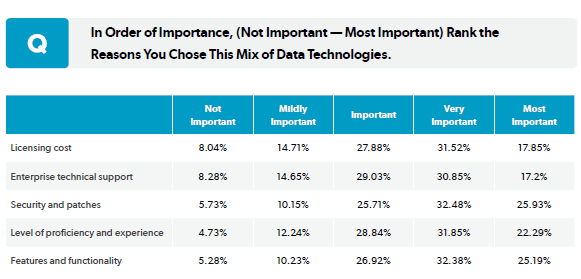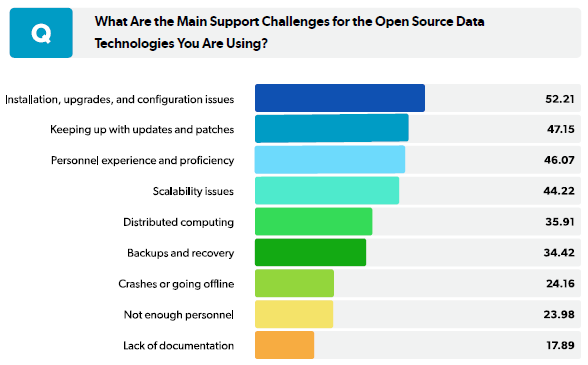
Ranking the Top Open Source Data Technologies of 2022
Editor's Note: The latest State of Open Source Report is now available, with more up-to-date information on open source data technology trends. You can access all previous State of Open Source Reports here.
Open source software trends move fast, and one of the fastest moving niches within the open source ecosystem is open source data technologies. So how can organizations keep up with these trends?
In this blog, we discuss the top open source data technologies, as told by our 2022 State of Open Source survey and report. We also discuss the reasons why organization are adopting open source data technologies, as well as the top challenges in doing so.
2022’s Top Open Source Data Technologies
For our 2022 State of Open Source Report, we surveyed over 2660 open source users to uncover the top technologies and trends in software today. One of the focus areas for the 2022 survey and report was around open source data technologies.
For this year’s report, we asked respondents to share the open source tools and technologies they use within their data stack.

MySQL was the most-used open source data technology at 35.2%, followed by PostgreSQL at 32.5% and MongoDB at 28%. MariaDB and Cassandra rounded out the top five at 21% and 19.2%, respectively.
1. MySQL
In our 2022 survey, 35.2% of respondents reported using MySQL. This is significantly lower than our 2020 report, which found 64% of respondents using MySQL. While there is some indication that MySQL use is declining, we think it’s much more gradual than these numbers indicate. Looking at DB-Engines ranking, they do note a gradual decline during this period.
2. PostgreSQL
32.5% of respondents in 2022 reported using PostgreSQL, making it the second most popular open source data technology in this year’s report. This represents a slight decrease from the 35% representation in the 2020 survey. These results are contrary to the DB-Engines rankings for PostgreSQL, which chart a steady growth pattern.
3. MongoDB
MongoDB was the third most popular open source data technology in our 2022 report, representing 28% of respondents. This number is lower than our 2022 report, which found 37% of respondents reporting use of MongoDB. DB-Engines does note a flat to negative movement between 2021 and 2022, but it doesn’t reflect the percentage dip we found during this period.
4. MariaDB
Our 2022 survey found MariaDB as the fourth most popular data technology, with 21% of respondents reporting using MariaDB in their data stack. This was a slight drop from our 2020 survey, where we found 24% using MariaDB. When comparing these numbers to the DB-Engines popularity trend, we found our numbers to be more negative than the gradual growth trend they show in the same period.
5. Cassandra
Cassandra was our fifth most popular data technology in 2022, with 19.2% reporting using it within their data stack. This number represents significant growth from our 2022 survey, which found only 11% using Cassandra. DB-Engines notes an uptick from 2020 to 2022 as well, with a popularity score that ran from 118 at the end of 2020, to 122 in March of 2022.
Back to topWhy Teams Choose Open Source Data Technologies
In 2022, we again asked respondents to rank the top considerations for choosing their open source data technologies.

Security and patches were selected as the most important factor for the selection of open source data technologies (26%). This speaks to the need to keep up with the latest patches to address bugs and security vulnerabilities.
At 25%, features and functionality was another important factor for the selection of open source data technologies. Due to the large variety of open source data technologies, this factor is very relevant since users can evaluate and test multiple options to compare functionality. In our 2020 report, features and functionality were the top reason for selecting open source data technologies.
Back to topTop Challenges With Open Source Data Technologies
In our 2022 survey, we expanded our questions around open source challenges to include questions for each technology niche. When asked to rank their top challenges in using open source data technologies, we found some interesting results.

Installations, upgrades, and configuration issues are the most selected challenge on open source data technologies (52%), followed by keeping up with updates and patches (47%), and personnel experience and proficiency (46%).
Perhaps surprisingly, not having enough personnel ranked low with 24% of the respondents, a significant contrast with the challenge to have personnel experience and proficiency with 46%. We can conclude that there is available personnel, but they are not proficient.
Back to topFinal Thoughts
The proliferation and maturation of open source database technologies has made them more relevant for enterprise organizations than ever before. And, as more verticals begin their digital transformation journeys, we only expect the adoption of open source data technologies to rise. This growth will be further hastened by the increasing feasibility and prevalence of AI/ML/DL applications across organizations of all sizes.
While we don’t know which data technologies will lead the charge, we do know that the amount of data organizations are generating will continue to grow – and necessitate both scalable and consistent data management solutions.
For organizations adopting open source data technologies, there are still challenges to overcome. As noted above, and throughout the survey, organizations will continue to face talent shortages in their technology facing roles. This ongoing struggle will make it more important than ever to enable existing teams – whether that’s through technology-based enablement, or through outsourcing things like open source technical support and patching.
Back to top